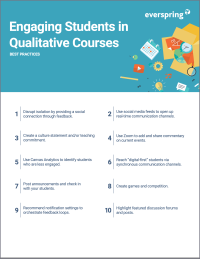Search
There are 11 results.
Tag
Tag
All (75)
Active Learning (4)
Activities (3)
Alt Text (1)
Analytics (4)
Assessments (5)
Asynchrony (5)
Belonging (3)
Canvas (2)
Case Studies (1)
Collaboration (3)
Color Contrast (1)
Communication (8)
Community (7)
Content Creation (19)
Course Materials (9)
Course Preparation (6)
Discussions (4)
Diversity (4)
Equity (2)
Faculty Presence (8)
Faculty Support (2)
Feedback (3)
Formative Assessments (6)
Game-Based Learning (2)
Gamification (1)
Generative AI (2)
Grading (1)
Images (2)
Inclusion (8)
Multimodality (7)
Page Design (1)
PowerPoint (1)
Qualitative courses (1)
Quantitative courses (1)
Representation (2)
Rubrics (1)
Screen Readers (1)
Social Media (1)
Synchrony (6)
Third-Party Tools (1)
Universal Design for Learning (UDL) (4)
Video (2)
Visual Accessibility (2)
Visual Design (1)
Engagement Series: Introduction
There are many components to consider when developing an online course; a key framework to inform course development is student engagement. The Glossary of Education Reform defines student engagement as “the degree of attention, curiosity, interest, optimism, and passion that students show when they are learning or being taught, which extends to the level of motivation they have to learn and progress in their education” (Great Schools Partnership, 2016, para. 1). Developing and evaluating course content through the lens of engagement can help instructors create an environment that is conducive to learning and mastery of course outcomes.
Inclusive Communication Practices
In asynchronous, hybrid, and multimodal learning environments, strong communication practices greatly aid student engagement and satisfaction (Martin & Bolliger, 2018). Faculty may develop an exceptional course in terms of goals, content, and design, but without proper communication and feedback, the course experience will be significantly diminished.
Inclusive Language
Inclusion entails creating an environment of open participation for all individuals. Using inclusive language across course content and communications can help reach every learner and ensure all students feel heard, valued, and validated (Márquez & Melero-Aguilar, 2022). This piece will explore the thoughtful use of inclusive language in online learning environments.
Taking Stock at the Midpoint of the Term
Halfway through the term isn't a great time to change around a bunch of materials or assignments in your course. However, it is a useful moment to evaluate how the course is going, realign to match the goals you set out at the beginning of the term, and determine what you may be able to tweak to make your course work more effectively for you and for your students. This piece suggests actions you can take at midterm to help shape the second half of the course.
First Time Teaching Online
The online learning environment may seem vastly different from the on-ground classroom. With the right preparation, however, you can successfully translate on-ground teaching and expertise into the online modality and create an engaging learning experience for students. In this piece, we will walk through things you’ll want to look for and decisions you’ll need to make when teaching online for the first time, regardless of what course you’re teaching. Additionally, we also provide some specific examples that are particularly relevant if you are using the Canvas learning management system.
Five Ways to Succeed as an Online Instructor
Whether experienced in or new to online teaching, following these tips on online instruction can make the process more intuitive. The online environment may seem vastly different from the classroom, but these tips will make it feel natural, allowing you to improve student experience, increase teaching efficacy, cultivate engagement, and ensure successful course management.










